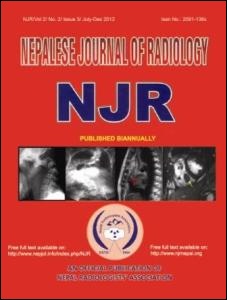Fetal Cardiac Interventricular Septal Thickness at 28–37 Weeks of Gestation in Nepalese Population
DOI:
https://doi.org/10.3126/njr.v2i2.7683Keywords:
Fetal echocardiography, Interventricular septal thickness, Maternal Diabetes MellitusAbstract
Objective: The purpose of this study is to establish a new reference range for fetal interventricular septal thickness in uncomplicated pregnancy at 28-37 weeks of gestation.
Materials and Methodology: This was a prospective cross sectional study involving 300 singleton pregnancies between 28-37 weeks of gestation without any known risk factors of adverse pregnancy outcome who were referred for routine obstetric examination. The protocol included the prenatal 2-dimensional M-mode echocardiographic measurements of fetal IVST and data were used to construct the normograms and percentile fitted curves for different gestational age. The relationship between the IVSD and IVSS and gestational age were determined.
Results: A total of 300 measurements were obtained. The normal values of the IVSD and IVSS according to gestational age were presented as 5th, 50th and 95th percentile ranks. The correlation coefficients (r) between the IVSD and IVSS and gestational age were 0.19 and 0.14, respectively. The weak correlation may be probably due to small sample size. The IVSD and IVSS were not statistically different with advancing gestation. The 95th percentile of the IVSD was 4.57 millimeters (mm) (range =4.12 to 4.62 mm) and IVSS was 6.67 mm (range = 5.81 to 6.77 mm).
Conclusion: The normal values of fetal IVSD and IVSS in a Nepalese population from 28 to 37 weeks’ gestation were established. This could be used as a baseline data in detecting the asymmetrical septal hypertrophy during fetal life.
Nepalese Journal of Radiology; Vol. 2; Issue 2; July-Dec. 2012; 36-42
Downloads
Downloads
Published
How to Cite
Issue
Section
License
This license enables reusers to distribute, remix, adapt, and build upon the material in any medium or format, so long as attribution is given to the creator. The license allows for commercial use.




